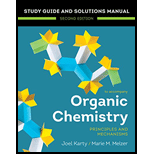
Concept explainers
Interpretation:
Using a molecular modeling kit, the molecule shown on the right in Figure 5-2a is to be oriented so that the C, Br, and F atoms occupy the positions shown in the second structure. The drawing of the molecule is to be completed by adding H and Cl atoms in the positions where they appear in the molecular model. Then, these two structures are to be compared to see if they are superimposable.
Concept introduction:
Enantiomers are mirror images of each other. To be isomers of each other, however, they must be different in some way. Enantiomers, therefore, are nonsuperimposable mirror images. Molecules are nonsuperimposable if there is no orientation in which all atoms of both molecules can be lined up perfectly (i.e., superimposed).
Want to see the full answer?
Check out a sample textbook solution
Chapter 5 Solutions
Organic Chemistry: Principles And Mechanisms: Study Guide/solutions Manual (second)
- Examine the ungraded ball-and-stick model below to determine the three-dimensional structure of the molecule. On the corresponding 2D structure, draw one wedge bond and one dash bond over two existing bonds to indicate the same arrangement of atoms in space. The narrow part of each wedge-and-dash bond should be towards the same central carbon atom.arrow_forwardThe structure below contains a charged carbon atom. Add the appropriate hydrogen atoms and lone pairs so that its valence matches the given charge.arrow_forwardCheck the box next to each molecule on the right that has the shape of the model molecule on the left: molecules model (check all that apply) O COCI, | CH;0 You can c CH4 O CH,Cl, O None of the above Note for advanced students: the length of bonds and size of atoms in the model is not necessarily realistic. Th geometry and 3D shape of the molecule.arrow_forward
- The problem is asking how many Sp3, Sp2, and Sp atoms there are and the answer key says 16 Sp3, 8 Sp2 and 2 Sp but I'm not even counting 26 carbons on this molecule so I'm a little confused.arrow_forwardIn the following Lewis structure of [(CH3)2OH]+, every atom, bond and lone pair is positioned. To complete the structure, drag the formal charge tags to the appropriate atom(s). Each marker may be used more than once, or not at all. If an atom has a formal charge of zero, do not drag a tag to it. When you drag the marker in, place the little crosshairs in the upper left corner of the marker directly over the atom(s) in question (not above them). H H-C-O-C-H HHH - H I Η Η Η 0 0 + 2+ 2-arrow_forwardTag all the sp² hybridized carbon atoms in this molecule. If there are none, please check the box below. H-C=C - H There are none.arrow_forward
- For the species below draw additional resonance structures (where all atoms have access to an octect of electrons) for species A, B, C, and D. Determine the bond order of the bond from the underlined C to underlined O for the lowest energy structure(s). You may need to evaluate the formal charge of the additional species you draw. These are species in an aprotic solvent, so only electrons may be moved, not hydrogen atoms. For each lettered structure below, input the bond order as an integer (1,2,etc) or improper fraction (4/3, 5/4, etc). A Structure Bond Order A HO: (f) H B B С Which structure A-D has the longest underlined C-O bond? :N=C=0: D Darrow_forwardOne of the ingredients in the Pfizer-BioNTech (mRNA) vaccine is shown below: но. N'arrow_forwardT 1C2: Draw multiple, valid resonance structures for line-angle structures using curved arrow notation and rank drawn resonance structures in order of their energy, stability, and contribution to the overall electronic nature of the structure. Fill in the data table with regard to the resonance structures given. Be sure to show all your important work for credit on this problem. Structure- Data Redraw Original Structure and Add Lone Pairs Redraw Original Structure with Lone Pairs and Add Curved Arrows to Neutralize as Many Formal Charges as Possible Draw Resonanc Structure That Follows From Curved Arrows Drawn Above ... Which Resonance Structure is Lower Energy (Original or Yours)? Why? HOO O OO OH CH3 O ✪ OH ⒸOH HOarrow_forward
- Follow the curved arrows and draw a Lewis structure for the resulting resonance contributor of 1,3-butadiene, adding charges and lone electron pairs to the appropriate atoms. CH2arrow_forwardNaming and Drawing Organic Molecules Comparing skeletal structures related by one fewer bond Could we cut just one bond in the "starting" molecule shown in the drawing area below to create this "target" molecule? The target molecule. If so, highlight the bond to be cut. If not, check the box under the drawing area that says Not possible. Note: it's OK if cutting the bond creates more than one molecule, as long as one of them is the target molecule. Not possible. Explanation Check MacBook Air G 1/5 Julianna 2024 McGraw Hill LLC. All Rights Reserved. Terms of Use | Privacy Center Accessibilityarrow_forwardTag all the carbon atoms with pi bonds in this molecule. If there are none, please check the box below. H | || :0: H-C- I H .. C-O-H There are none. Xarrow_forward
 Organic Chemistry: A Guided InquiryChemistryISBN:9780618974122Author:Andrei StraumanisPublisher:Cengage Learning
Organic Chemistry: A Guided InquiryChemistryISBN:9780618974122Author:Andrei StraumanisPublisher:Cengage Learning Organic ChemistryChemistryISBN:9781305580350Author:William H. Brown, Brent L. Iverson, Eric Anslyn, Christopher S. FootePublisher:Cengage Learning
Organic ChemistryChemistryISBN:9781305580350Author:William H. Brown, Brent L. Iverson, Eric Anslyn, Christopher S. FootePublisher:Cengage Learning

